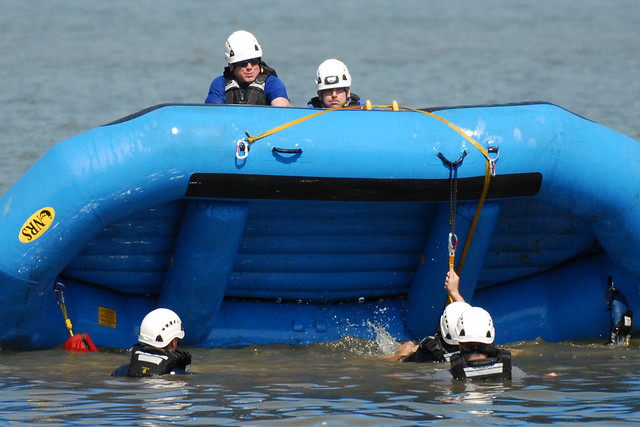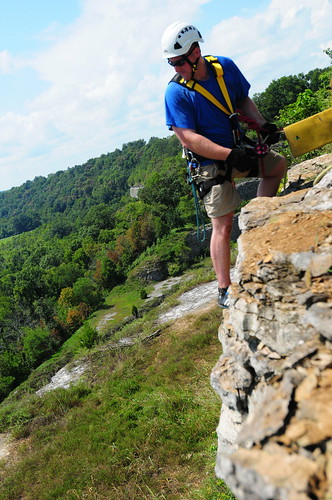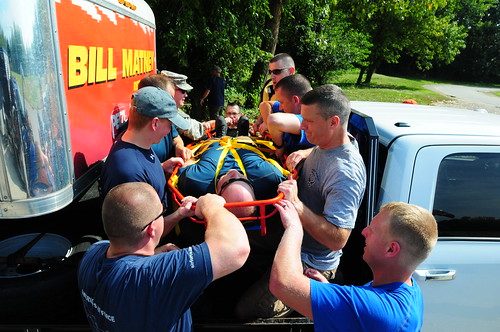Story by Staff Sgt. Scott Raymond, Kentucky National Guard Public Affairs
[caption id="" align="aligncenter" width="576"]

Members of the 41st Civil Support Team attempt to right a capsized raft in the Ohio River near Louisville, Ky., Aug. 27, 2013. The exercise was part of the unit's training on swift water rescue operations. (U.S. Army National Guard photo by Staff Sgt. Scott Raymond)
LOUISVILLE, Ky. -- Many know of the skill-set of the Kentucky National Guard's 41st Civil Support Team. They are the go-to guys for any situation involving chemical, biological, radio-active or nuclear materials (CBRN). They have proven time and time again through real-world actions and excellence in proficiency checks that they are among the best of the best in the Nation.
But what the team wants everyone to know is that their abilities go far beyond their response to such incidents.
[caption id="" align="alignright" width="232"]

Sgt. Jacob Beach of the 41st Civil Support Team prepares to rappel down a cliff as part of a training exercise in Frankfort, Ky., Aug. 21, 2013. The unit received professional instruction on methods of technical rope rescue for use in urban operations during natural or man-made disasters. (U.S. Army National Guard photo by Staff Sgt. Scott Raymond)
To be up to the task 24/7, the team trains constantly, but recent exercises have taken them out of their usual element. To enhance that broad skill-set of the 22-man team, the Soldiers and Airmen gathered in August to practice technical rope rescues and swift water rescues.
To see more photos of the 41st's training, click here.
"The 41st is known for their response to CBRN responses, and we are exceptionally good at doing that," said Lt. Col. John Cline, commander of the 41st. "After Hurricane Katrina hit, the missions of all civil support teams across the Nation changed to include response to natural and man-made disasters."
"This training relates to that for our response to floods, where we not only could rescue individuals in difficult situations, but also perhaps to pull drums of hazardous materials out of the water," he said. "And anything that involves ropes is closely related with most of our operations for urban rescue."
The team first came together for instruction on rope rescues in Frankfort, Ky., on the cliffs overlooking U.S. 127. Bill Matney, an emergency service instructor from Greensburg, Ky., provided both training opportunities.
"What we are giving them is options," said Matney, owner and operator of Matney Consulting and Training. "We're giving them tools for their toolbox, new methods and increasing their functional capabilities."
Team members were taught fundamentals of rope rescue, including proper knots to tie, line anchor points and belay operations. They were then able to put the lessons to use as the team members played various roles in ascending and descending the cliffs in scenarios similar to what they may encounter in a real-world rescue.
The team next set up on the banks of the Ohio River in Louisville, Ky., for the swift water rescue training. The water-borne operations included instruction in hazard recognition, equipment use, and basic shore and boat-based rescue techniques.
"With the new natural disaster role, we looked at what the state needed as a whole and found some gaps so that's why we're here doing this," said Sgt. 1st Class Steven Baker, a CBRN Specialist with the 41st.
[caption id="" align="alignleft" width="350"]

Soldiers and Airmen of the 41st Civil Support Team work to transport a fellow team member over an obstacle during training in Louisville, Ky., Aug. 27, 2013. The exercise demonstrated the difficulties of rescues performed in confined spaces and how to overcome the challenges. (U.S. Army National Guard photo by Staff Sgt. Scott Raymond)
"I think this is going to continue to enhance our skills and make us an even better asset to the state," said Baker.
In addition to the rope and water rescue training, Matney also included lessons on confined space rescues. The 41st was instructed on how to properly secure a victim in a litter and how to move within restricted and unusual spaces.
Matney said he works with and trains a wide variety of first-responders and agencies, and commented on how impressed he was with the skills of the Soldiers and Airmen in the unit.
"I do this for a living, and I can tell you who is good and who needs more," said Matney. "This crew is not here because they were told to be, they're here because they want this. The quality of their leadership, their talent and their motivation is very impressive."
"Overall, this is just great training to have," said Cline. "We haven't had to put it into action yet, thankfully. But if we do, we will be fully prepared to do so."